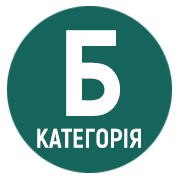СТІЙКІ СПОЛУЧЕННЯ СЛІВ ЯК ЗАСОБИ ВИРАЖЕННЯ КОНТРАСТУ В СУЧАСНОМУ ПРОЗОВОМУ ТЕКСТІ (НА МАТЕРІАЛІ РОМАНУ ДАРИ КОРНІЙ «ТРОЯН-ЗІЛЛЯ»)
DOI:
https://doi.org/10.32782/2412-933X/2025-XXIII-9Ключові слова:
фразеологізм, контраст, художній текст, стійкі сполучення слів, текстотвірна функція, характеротвірна функція, атракційна функція, функція динамізації сюжетуАнотація
У статті висвітлено роль фразеологічних одиниць у формуванні контрастності художнього тексту на матеріалі сучасного українського роману Дари Корній «Троян-зілля». Метою наукової розвідки є з’ясування того, як стійкі сполучення слів формують контрастність у романі, а також аналіз функційних особливостей фразеологізмів та розкриття їхнього смислового потенціалу у створенні протиставлень у художньому тексті. Визначено основні функції фразеологічних одиниць у тексті, а саме: текстотвірну, характеротвірну, динамізації сюжету та атракційну. Виявлено, що текстотвірна функція фразеологізмів як засобів творення контрасту полягає у формуванні цілісної структури тексту через систему протиставлень на різних рівнях його організації; характеротвірна сприяє характеристиці персонажів, розміщенню їх на оцінній шкалі від «+» до «-», формуванню системи образів та створенню художньої картини світу; функція динамізації сюжету інтенсифікує текст, рухає дію, сприяє розгортанню оповіді на всіх рівнях; атракційна привертає увагу до ключових моментів тексту, наголошує на їх важливості при рецепції та активізує сприйняття. Підкреслено, що всі розглянуті функції доповнюють одна одну та тільки у співдії формують художній зміст, гарантують його донесення до реципієнта, створюючи багатовимірний художній простір та сприяючи повноцінному сприйняттю тексту. Встановлено, що фразеологізми відіграють важливу роль у формуванні як окремих образів, так і загальної структури художнього тексту. На основі проведеного дослідження зроблено висновок про значний потенціал фразеологічних одиниць у створенні контрастності та їхню роль у розкритті авторського задуму. Результати дослідження можуть бути використані для подальшого вивчення функціонування фразеологізмів у художніх текстах та аналізу засобів створення контрастності в сучасній українській прозі.
Посилання
Бобух Н.М. Семантико-стилістичні функції контрастивів у художньому тексті Івана Нечуя- Левицького. Лінгвістика. 2019. № 2 (41). С. 119–128.
Бойко Н.І. Українська експресивна лексика: семантичний, лексикографічний і функціональний аспекти : монографія. Ніжин : ТОВ «Видавництво «Аспект-Поліграф», 2005. 552 с.
Бойко Н.І. Контраст як ознака ідіолекту Євгена Маланюка. Культура слова. 2018. № 89. URL: https://ks.iul-nasu.org.ua/vypusky-zhurnalu/2018-2/zbirnyk-kultura-slova-89-2018/kontrast-yak-oznakaidiolektu-yevgena-malanyuka.html (дата звернення: 05.10.2022).
Буланович Н.О. Контраст як змістова категорія тексту. Англістика та американістика. Дніпропетровськ : Вид-во ДНУ, 2006. Вип. 3. С. 18–22.
Векуа Н. Антонімія як лексико-семантичне явище. Дивослово. 2007. № 6. С. 26–32.
Гриня Н.О. Семантичні та композиційні типи контрасту в сучасному художньому дискурсі. Наукові записки Вінницького державного педагогічного університету імені Михайла Коцюбинського. 2013. Вип. 17. С. 186–189.
Дара Корній. Троян-зілля : роман. Харків : Віват, 2021. 304 с.
Кажан В.І., Калініна Р.П. Антонімічний контраст у прозі В. Шевчука. Філологічні студії. 2010. Вип. 4. С. 73–83.
Лотоцька К. Антитеза: когнітивні, функціональні та мовні аспекти аналізу. Наукові записки Тернопільського державного педагогічного університету імені Володимира Гнатюка. Серія «Мовознавство». 2002. № 2 (8). С. 93–99.
Селіванова О.О. Лінгвістична енциклопедія. Полтава : Довкілля, 2010. 844 с.
Стефурак Р.І. Лексико-семантичний контраст – конститутивний елемент поетичного тексту Богдана Томенчука. Вчені записки Таврійського національного університету імені В.І. Вернадського. Серія «Філологія. Журналістика». 2021. Том 32 (71). № 2. Ч. 1. С. 62–66.






